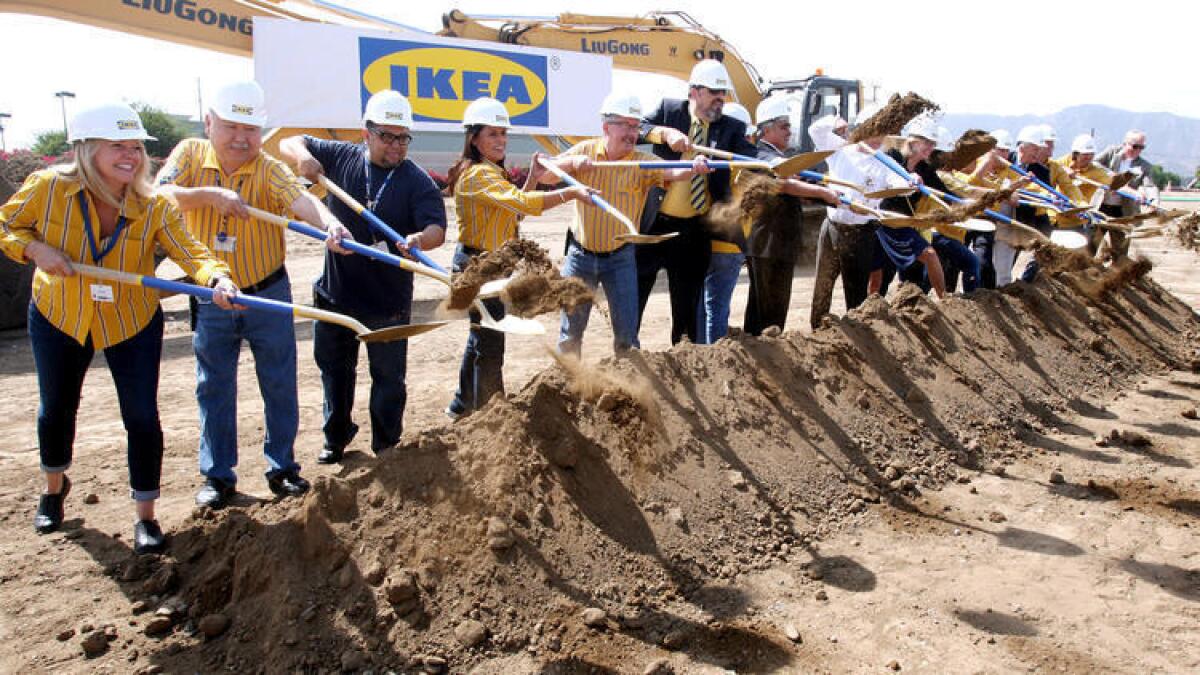Op-Ed: IKEA move leaves a land-use vacancy

IKEA employees and city officials throw the ceremonial dirt as construction begins for the new IKEA in Burbank on Tuesday, Sept. 1, 2015. When completed, the new 456,000 sq. ft. store, on 22 acres on San Fernando Rd., will be the largest one in the United States.
- Share via
It is very exciting to see the construction taking place on the new and much larger IKEA store. I was city manager when we brought IKEA to Burbank. It seemed like such a big risk at the time. No one had even heard of IKEA. I had to go to Minneapolis just to see one. We imposed a sales tax guarantee on them and the right to take back the land if the store failed. Of course, it turned out to be Burbank’s most successful retailer and has brought in millions of dollars of tax revenues.
To me it is now even more exciting to think about what will be built in place of the original IKEA. The truth is that just as IKEA exceeded our expectations, the mall and the satellite pads around it never lived up to our original vision.
The smaller pads around the mall and IKEA were master planned to have large tax- and job-producing office buildings and a major hotel. When the economy slowed down, we had to make a decision to leave the parcels vacant until the economy recovered or to put in interim uses. We chose the latter and all of the free-standing stores we see today were constructed, including Office Depot, Warehouse Discount Center, In-N-Out Burger, El Pollo Loco and Ashley Furniture.
Some have been successful, but most have struggled. Remember Circuit City, Virgin Records and Comp USA? Free-standing, single-story buildings with large surface parking lots do not work well in the urban village design of downtown Burbank.
What to do with the current IKEA site and the other surrounding satellite pads will be the most important land-use decisions this City Council will ever make! Millions of dollars of tax revenues to help pay for our essential city services are at stake, as well as hundreds of badly need jobs for our people. I urge the City Council to think long and hard before making these decisions that will impact the future of Burbank for decades to come.
The choices will not be easy. For example, I do not think these sites can be replaced with similar retail uses. With the success of other major retail centers like the Americana in Glendale or our Empire Center, as well as the phenomenal growth of online shopping, there are not enough major retailers left to successfully fill this space.
Although the original vision called for high-rise office buildings, I do not think that is realistic today. Most of Burbank’s new office construction will more likely happen in the Media District or near the airport.
Probably the most viable use will be residential. But it should not be just any residential. It certainly should not be the wood-frame apartment buildings of two or three stories that have been so common in Burbank. It should be a smart design that not only relates to the mall, but is also seen as an integral part of all of downtown Burbank, stretching from Verdugo Avenue to Burbank and Glenoaks boulevards to the freeway.
Never since we tore out the Golden Mall, reopened San Fernando and built the original Media City Center (which included IKEA and the satellite pads) has it been so important to look at the whole and not just the individual pieces. The full economic impact comes from how all of these pieces work together. The right development at the IKEA site and the satellite pads will financially benefit the mall and empty space in downtown. It should be done in such a way as to create an incredibly desirable place to live, within easy walking distance of shopping, dining and entertainment.
Height could probably vary from a minimum of five stories above a podium of community serving retail to a maximum of 10 to 15 stories, which is consistent with the existing high-rise buildings in downtown. There should be a good price mix, ranging from affordable to higher end. Although some rental units should be provided, a primary emphasis should be on home ownership, perhaps with a first-time home buyers program.
I cannot stress enough how exciting, but also how important these decisions are going to be. The very future of downtown Burbank rests with what the City Council does this year.
--
ROBERT R. “BUD” OVROM is a Burbank resident and the former Burbank city manager.